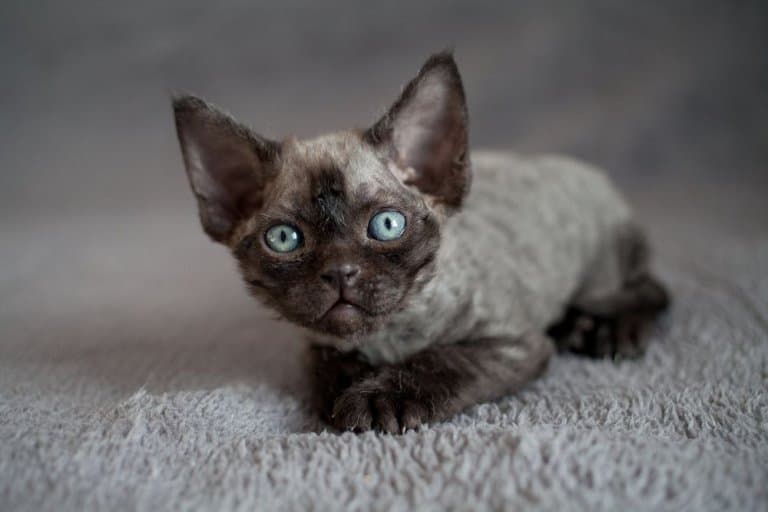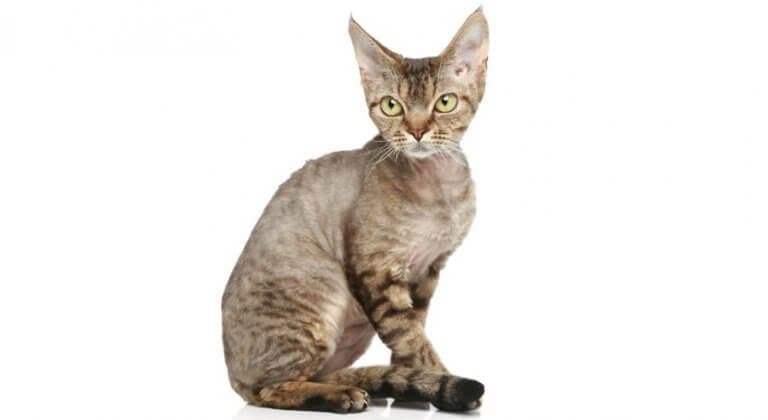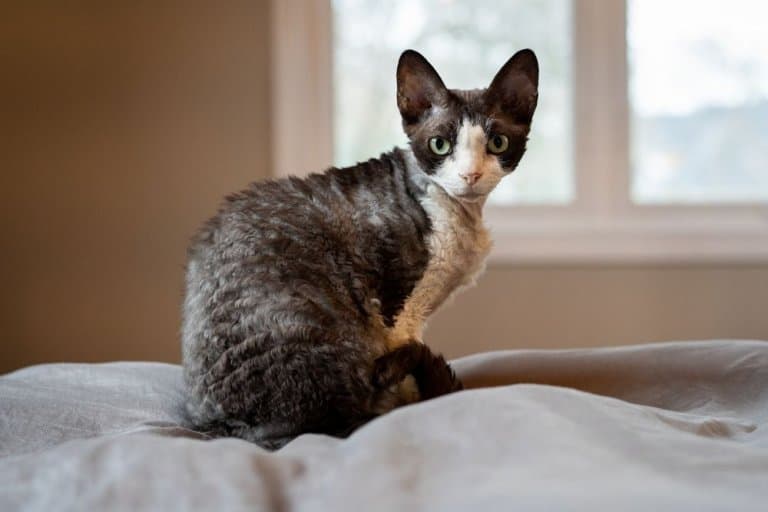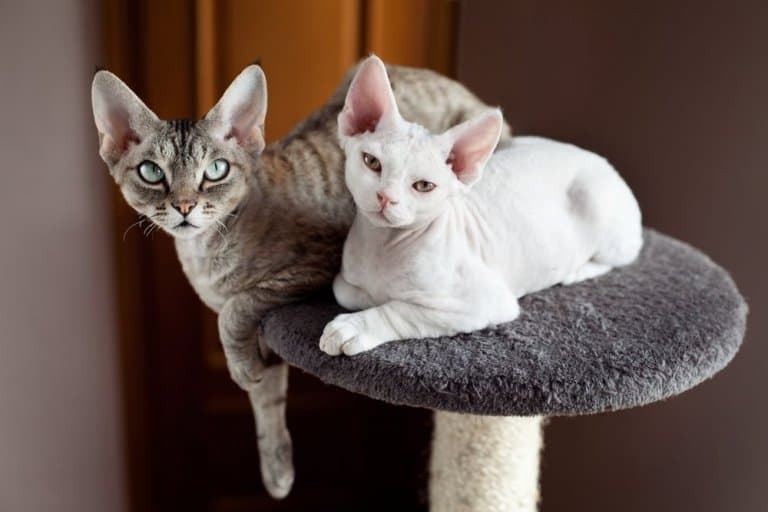
devon-rex
Doglike, energetic, people-oriented, mischievous
Overview
Origin
United Kingdom
Life Span
10-15 years
Height
12"-14"
Weight
6-9 pounds
Group
Small to medium-sized shorthair
Price
$600-$2,000
History

In 1959, a short-haired domestic cat owned by Beryl Cox of Buckfastleigh, Devon, England, gave birth to a litter of kittens. One of these had a short, curly coat. The litter’s father was believed to be a tomcat with a curly coat, that frequented an old abandoned tin mill in the area.
Beryl Cox knew about the Cornish Rex cat breed and she thought that the curly coated kitten might be related. She named the kitten Kirlee and when he matured, she brought him to a Cornish Rex cat breeder, who paired him with one of their females.
The resulting litter contained kittens with normal, straight coats, signifying that Kirlee had a different genetic mutation than the Cornish Rex. The gene that gives the Devon Rex’s coat its unique texture is Devon gene. Eventually, a breeding program was established and the Devon Rex was developed as as separate breed. Even today, all Devon Rex cats can be traced directly back to Kirlee, the original curly coated kitten.
With a successful breeding program in place, the Devon Rex quickly gained popularity. Devons first made their way to the United States in 1968, and in 1979, the breed was officially recognized by the Cat Fanciers’ Association (CFA). Today, the Devon Rex is accepted by The International Cat Association (TICA) and all other major cat registries.
Care

Nutrition
Devon Rex cats don’t have any special nutritional requirements, but they do need a high-quality food with ample protein. Since these cats are small-statured, obesity can cause serious joint pain and other issues. It’s very important to keep Devon Rex cats at the correct weight by offering the right amount of food and avoiding excess carbohydrates. Feed measured meals rather than leaving food out all the time, which can lead to overeating.
Grooming
As low-maintenance cats go, the Devon Rex is a champion! These cats have barely any hair to brush, although they might enjoy a warm bath if poor distribution of body oils causes a greasy feel.
Exercise
The Devon Rex is an athletic breed and you shouldn’t have to make much of an effort to keep them entertained. At the same time, your cat will appreciate a well-stocked basket of toys, as well as a cat tree and at least one scratching post. They'll be happy to play fetch with you and learn other tricks whenever you have time.
Health
While the Devon Rex generally enjoys good health, there are some known issues with the breed, including hypertrophic cardiomyopathy, which is a form of heart disease. Some have hereditary myopathy called Devon Rex myopathy, which is an inherited condition that affects muscle function. Some Devon Rex have a musculoskeletal disorder called patellar luxation.
Breed Standard

Body
Devon Rex cats are small to medium-sized with a fine frame. They are hard and muscular, with broad chests.
Head
The head is a modified wedge shape. Seen from the front, the wedge displays distinct convex curves at the outer edge of the earlobes, the cheekbones, and the whisker pads. The head is slightly longer than it is broad. The cheekbones are pronounced, and a whisker break is evident. Adult males may display jowls.
Eyes
The eyes are large and wide-set, with an oval shape and a distinct slope toward the outer edges of the ears. All eye colors are acceptable.
Ears
A Devon Rex cat’s ears are very large and are set low on the head. They are extremely wide at the base, with the outer edge of the base extending beyond the line of the facial wedge. The ears have rounded tips. Earmuffs are permitted, as are tufts at the tips of the ears.
Color
Devon Rex cats may be of any color or pattern. Nose leather and paw pad color complement the coat color.
Coat
The Devon Rex cat is well covered with short, fine, wavy fur, with the coat displaying its greatest density on the cat's back, sides, legs, tail, face, and ears.
Tail
The tail is long, slim, and tapered. It is well covered with short fur.
Legs & Paws
The legs are long and slim. The paws are small with an oval shape.
Personality & Temperament

Petite size, pixie-like facial features, and an incredibly sociable personality make the Devon Rex cat a favorite breed among cat lovers. The Devon Rex has a unique coat that makes it stand out from the rest: soft, ultra-fine fur with a wavy texture—there’s nothing else quite like it.
If you've been looking for a non-shedding cat, the Devon Rex comes close. Although there's no such thing as a fully hypoallergenic cat breed, Devon Rex cats have such fine, short hair and shed so little that they leave barely a trace of themselves behind on furniture and clothing.
Elvin facial features, including massive wide-set eyes and huge bat-like ears, also contribute to the Devon Rex cat’s signature appearance. Their personalities might be described as elvish too. These fun-loving cats are incredibly inquisitive, often following their family members around in an attempt to be involved in whatever is happening.
Sometimes described as part dog, part cat, and part monkey, Devon Rex cats are accomplished climbers, and they’ll do whatever it takes to perch in the highest spot they can find, preferably one with a great view. They have an appreciation for tiny hiding places, too. Their owners might find them tucked behind the refrigerator, hiding under the sofa, or peering out from the insides of bookshelves.
Easily trained, Devon Rex find a great deal of enjoyment in outdoor walks (leashed, of course!) and rousing games of fetch. When playtime comes to an end, the Devon Rex loves to settle down and enjoy affectionate cuddles. These cats seek attention from their human family members, and they also have a reputation for getting along well with other pets.
While Devon Rex cats are friendly toward everyone, it’s worth noting that they tend to choose a favorite person with whom to share most of their affection. As talkative as they are cuddly, they tend to converse in a series of chirps and trills rather than traditional meows.